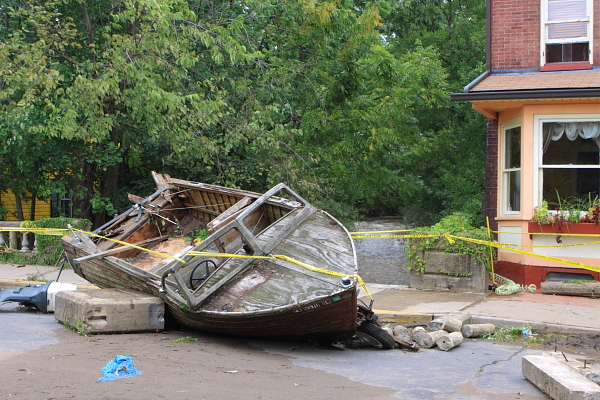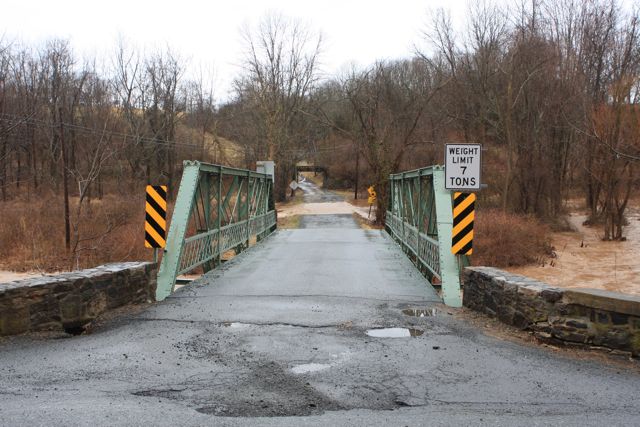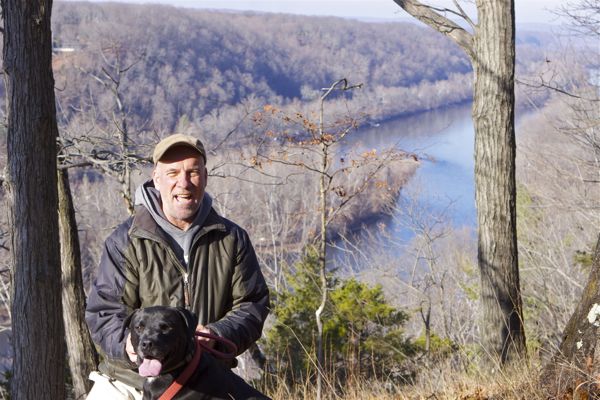Rule Must Be Vetoed By Legislature
Vague New “Public Interest” State Standard Can Not Block FERC Pipelines
No Linkage to Clean Water Act’s Surface Water Quality Standards
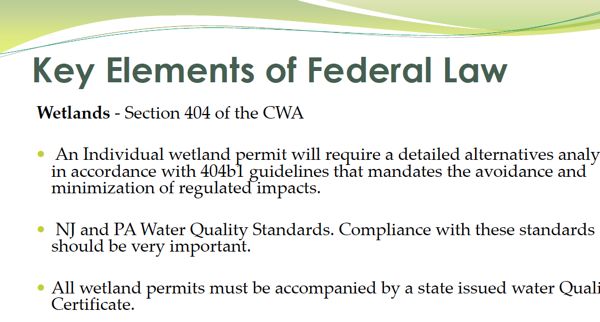
DEP’s revised proposal does not include enforceable links to NJ water quality standards (Source: Princeton Hydro)
I want to focus today on the DEP’s “concurrent proposal” (CP) of changes to the Flood Hazard rule that is pending Legislative Veto.
The concurrent proposal (CP) is allegedly designed to “fix” the flaws in the original proposal and respond to overwhelming public criticism that led to the Legislature’s veto initiative.
Curiously, before the concurrent proposal (CP) was even available for public review, the Senate Environment Committee Chairman already seemed to have come to a conclusion:
Earlier in the meeting, the tone was much more conciliatory with Smith, the only one outside the department who has read the revised rule, saying there is no question there has been some progress in improving the regulation. (NJ Spotlight – 5/17/16)
No question? None?
Just as curiously, the CP was quietly posted to the DEP website late last week and – unlike any proposal I’ve ever seen – it does not include a NJ Register publication date or a formal public notice. Thus, it has no legal standing at this point and in fact is NOT yet a formal proposal. It has no more legal status and should be afforded no more credibility than a DEP press release.
I will focus today only on the DEP’s alleged “Improvements to riparian zone protections (N.J.A.C. 7:13)” – more specifically, the Additional protections for the inner 150 feet of a 300-foot riparian zone (7:13-11.2(d)) (discussion starts on p.14)
There is specific stuff in the concurrent proposal that almost surely came from Jon Miller of Princeton Hydro, consultants to PennEast pipeline opponents and the Rethink NJ Energy crowd.
DEP very likely included these “improvements” as a concession and carrot to some conservation community critics to create the false appearance that they will use it to deny pipeline stream encroachment permits.
I strongly suspect that these “improvements” are the political deal that bought off a large segment of the conservation community opposition and that will provide political cover for the Legislature’s abandonment of the veto, so it is important that I expose that lie.
The CP actually undermines DEP’ ability to enforce the critical Clean Water Act Section 401 Water Quality Certification requirements, as recently used by the NY DEC to kill the proposed Constitution pipeline.
[* This results from repeal of the C1 SWRPA, which was the link to the Clean Water Act and NJ State Water Quality Standards.]
I) Context: Climate change, headwater streams and longstanding SWRPA C1 buffer disturbance prohibition was ignored
At the outset, it must be noted that the CP fails to include necessary new restrictions to address climate change risks from sea level rise, storm surge, and inland river flooding, and to close gaping loopholes that result in a lack of protection of headwater streams with no defined bed and bank or that drain less than 50 acres.
These omissions are fatal flaws.
The more specific stream buffer context readers should consider these alleged “improvements” within is DEP’s extraordinary statement in the rule adoption response to comments document regarding the “Special Water Resource Protection Area” (SWRPA) Category One 300 foot buffers that the “riparian zone” would replace.
Much of the controversy over these rules focused on the repeal of the 300 foot wide Category One buffers (known as a “SWRPA”) and replacement by a less protected “riparian zone” and how the proposal would allow more disturbance and development of C1 stream buffers, particularly inside the 150 feet and closer to the stream.
Specifically, the SWRPA C1 buffers had a bright line prohibition on buffer disturbance inside 150 feet to the stream. DEP just admitted that this bright line prohibition was never enforced.
As DEP notes, citing the rule text at N.J.A.C. 7:13-5.5(h)1ii, the current rules strictly prohibit disturbance and development inside 150 feet:
In no case shall the remaining SWRPA be reduced to less than 150 feet
“In no case” – NO means no. None. Sorry, can’t do that. If a landowner objected, they could exhaust administrative remedies and then file a “takings” challenge and see if the courts agree. Good luck with that (look at takings waiver in Highlands rules, NJAC 7:38-6.8).
But, shockingly, DEP – for the first time – now says that NO means YES.
DEP now claims that they flat out violated that regulation for 12 years and routinely reduced the buffer to less than 150 feet and approved development inside the 150 feet!
Thus, while N.J.A.C. 7:13-5.5(h)1ii provides no allowance for any disturbance within the inner 150 feet of the 300-foot SWRPA, and permits limited disturbance in the outer 150 feet, the Department has authorized encroachments into these portions of the SWRPA under the hardship exception provisions of the FHACA Rules and other relevant permitting programs cited in the response to comment above under which the SWM rules have been implemented. Since the Department amended the FHACA Rules and expanded the riparian zone along Category One waters to 300 feet in 2007, all encroachments within the SWRPA, which required a flood hazard area individual permit and were not otherwise provided for under prior N.J.A.C. 7:8-5.5(h), have been processed under the hardship exception provisions of the FHACA Rules at prior N.J.A.C. 7:13-9.8.
The SWRPA was never a “no-build” regulation. Instead, disturbance, while discouraged, was allowed in limited circumstances. (see page 118)
To justify this flagrant violation of their own regulations the DEP, after the fact, remarkably cites a response to comment in the 2004 rule adoption document!
The Department anticipated that unavoidable encroachments would need to be allowed when the SWM rules were adopted on February 2, 2004, and indicated that the hardship provisions, found in other permitting rules, created a process for allowing such encroachments (see response to comments 440-441, 36 N.J.R. 716).
If DEP lacked the backbone to enforce a bright line numeric regulatory standard against developers and landowners to alter the footprint of minor developments, how is it possible to be so naive to think that DEP will rely on some new vague “public interest” standard to block multi-billion dollar gas pipelines?
This question takes us to part II.
II) The so called “Improvements to riparian zone protections (N.J.A.C. 7:13)”
The DEP’s proposed “improvements” fail for 2 fundamental reasons:
1) the entire stream encroachment permit program allows stream buffer disturbance by right.
2) If those by right disturbance standards are “not feasible”, the DEP merely requires mitigation.
As a result, the concept of a permit denial is not even on the table. The DEP explicitly states that loophole, i.e. “limited situations“:
The inner 150-foot portion of a 300-foot riparian zone is essential for maintaining water quality, ecological health, and fisheries resources associated with Category One waters. However, the Department recognizes that there are limited situations in which conducting regulated activities within the inner 150-foot portion of a 300-foot riparian zone is necessary. The proposed requirements are intended to ensure that only those projects that have no alternative other than being located within the inner portion of the 300-foot riparian zone will be allowed and serve to strengthen the already stringent requirements for regulated activities in a riparian zone.
The CP makes this disturbance “by right” mitigation policy abundantly clear.
Here it is in the summary:
Requiring mitigation for individual permit impacts in a 300-foot riparian zone with limited exceptions is intended to strengthen the protections afforded these areas. This is appropriate since, as discussed earlier in this summary, 300-foot riparian zones adjacent to Category One waters are intended to protect, among other things, the quality of these waters. (p.27)
Here it is in the actual rule text:
Where the regulated activity is located within a 300-foot riparian zone, is an activity identified at (r), (s), or (y) below, or the total amount of clearing, cutting, and/or removal of riparian zone vegetation exceeds the limits in Table 11.2, mitigation is required in accordance with N.J.A.C. 7:13-13.4. (p. 94)
To obfuscate this fundamental flaw – on top of the DEP’s historical failure to enforce a bright line regulatory prohibition of disturbance and development of the inner 150 foot C1 buffer I discuss above – the DEP CP creates a false impression that the Department has the regulatory authority and the political will to deny stream encroachment permits and to enforce buffer and water quality standards.
First, the DEP summary falsely claims that the stream encroachment permits are linked to compliance with surface water quality standards, “similar to” the wetlands regulations:
These requirements are similar to the requirements at N.J.A.C. 7:7A-7.2(b) for the issuance of a freshwater wetlands or open water fill individual permit, with amendments to reflect that the proposed subsection is only applicable to riparian zones to a Category One water, making some of the considerations applicable in the freshwater wetlands context not applicable under this subsection, and are intended to ensure that activities within 150 feet of a Category One water or regulated tributary to a Category One water are only conducted when there is no alternative to the activity and that the activity will not lead to the violation of State water quality standards and laws or otherwise have significant adverse environmental consequences.
The wetlands regulation (NJAC 7:7A-7.2(b)) that DEP claims the CP is “similar to” explicitly requires that wetlands permits:
5. Will not cause or contribute to a violation of any applicable State water quality standard;
But the actual text of the CP rule does not include this language from the wetlands rules. While other provisions from the wetlands rules were included in the CP, this critical language was not.
The CP does not require compliance with State water quality standards or include this “cause or contribute to” language from the wetlands rules.
The wetlands rules include that specific requirement because it was necessary to receive delegation of the federal Clean Water Act. The implications of that are HUGE:
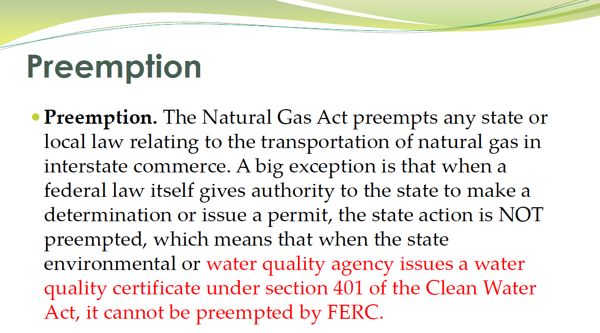
But that critical provision has been ignored historically by the DEP and freshwater wetlands permits are issued without a required demonstration with State water quality standards. Instead, DEP relies on avoidance, minimization and mitigation via BMP’s.
This is the issue that pipeline activists must engage and force DEP to change their historical permit review practices and begin to enforce this requirement to comply with State water quality standards in the land use permit program.
The DEP is engaging in incredibly dishonest practices by falsely claiming that the stream encroachment rules now include a provision “that the activity will not lead to the violation of State water quality standards”. It is simply not there.
On top of that, the CP fails to cite and mandate compliance with the Surface Water Quality Standards, the anti degradation policy in the SWQS, or the numeric and narrative criteria in the SWQS.
Here are the changes, notably absent is this regulatory standard: “Will not cause or contribute to a violation of any applicable State water quality standard;”
- Proposed N.J.A.C. 7:13-11.2(d)1 requires the applicant to demonstrate that a regulated activity proposed within the inner 150 feet of a 300-foot riparian zone has no practicable alternative that would result in less adverse impact on the regulated water and its riparian zone and which would not cause other significant adverse environmental consequences.
DEP historically has taken the position that there are no practical alternatives for stream crossings for pipeline routes. SAme think for all linear infrastructure and thins like bridges to develop land locked parcels.
- Proposed N.J.A.C. 7:13-11.2(d)2 requires an applicant to demonstrate that the proposed activity will result in minimum [feasible] alteration or impairment of the riparian or aquatic ecosystem. Category One waters may be designated as such due to ecological significance or their significant fisheries resources. The Department therefore will not issue an individual permit for an activity within the inner 150 feet of a 300-foot riparian zone if the activity would significantly alter or impair the riparian and aquatic ecosystem.
Note that DEP’s rule summary omitted the key word “feasible”. Is this economic feasibility? Technological feasibility? Engineering feasibility? By what methodologies will this standard be enforced?
How does this language apply to stream trenching for pipeline crossings, which historically were approved by DEP?
You can be sure this lack of clarity will be exploited to render this rule unenforceable.
If DEP were serious, all these open ended issues would be nailed down and there would be specific methodologies identified with specific enforceable standards, linked to the anti degradation review standard for C1 waters and the numeric and narrative standards in the SWQS.
- Proposed N.J.A.C. 7:13-11.2(d)3 requires the applicant to demonstrate that the proposed regulated activity is in the public interest.
Here is the loophole DEP designed as an escape hatch, or to provide “flexibility”, or what the regulatory wonks refer to as a “feasibility standard” or an “exit ramp”
If the purpose of the activity could feasibly be accomplished in a way that does not involve the clearing, cutting, and/or removal of vegetation within 150 feet of the top of bank of a water with a 300-foot riparian zone, proceeding with the activity in the inner 150 feet of the riparian zone is clearly not in the public interest.
III) The fingerprints of the deal
In closing, this is a very inside baseball and technically nuanced point, but the smoking gun that strongly suggests the political deal is found in two places:
1) I specifically recommended the wetlands provision as the bridge to the CWA 401 WQ certificate issue, i.e. that the activity will not lead to the violation of State water quality standards.
The fact that this is mentioned in the rule summary but not the rule text suggests an intent to mollify this criticism and frustrate actual enforcement of that standard; and
2) At the conclusion of the DEP’s March 15 stakeholder meeting on these rules (see attendees), Jon Miller of Princeton Hydro recommended that DEP not rely on a FERC CPCN as the basis for demonstrating that a project was in the public interest (you can take my word for it or listen to the MP3 audio posted in DEP website to confirm).
Because Jon is very familiar with the Clean Water Section 401 issue and is working with PennEast pipeline opponents, I was quite surprised that he didn’t go further to suggest the need for enforceable regulatory and technical linkages to the Surface Water Quality Standards, which are necessary to enforce the federal CWA 401 WQC in the State stream encroachment permit program, as I have. This would follow the NY DEC approach in the Constitution pipeline denial of the 410 WQC.
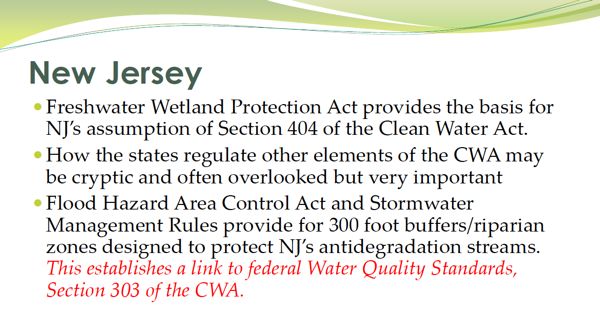
The inclusion of a new “public interest” standard in the proposal, which includes an illustration of a public utility pipeline case, is more than a coincidence and is very likely based on Jon Miller’s recommendation.
I’ve therefore tried to explain above why it won’t work and is fatally flawed. I’ve also explained how NY DEC’ denial of the 401 WQC relied on technical and regulatory linkages to enforce State WQS.
I’ve made these same arguments with DEP’s legal representatives (Deputy Attorney General) about lack of enforcement of the SWQS in land use programs for many years while at DEP and lost those arguments. The DAG’s always claimed that to do so would require asserting very broad regulatory control over non-point source pollution – which was perceived as politically infeasible. To confirm this, read the Jan. 6, 2003 NJ Register on adoption of the C1 300 foot buffers (35 NJR 135).
There is one close exception, the Milligan Farms case. Take my word for it, or do some research on Milligan Farms revocation of a previously issued DEP NJPDES permit for discharge to a C1 stream, and see for yourself. But that still involved a point source discharge under a NJPDES permit , not non-point loads to the C1 stream.
Or, just look at the recent DEP’s proposed “Forest Stewardship Plan” for Sparta Mountain WMA, where the lack of enforceable SWQS in lieu of reliance on BMP’s is obvious on the stream buffer issues.
